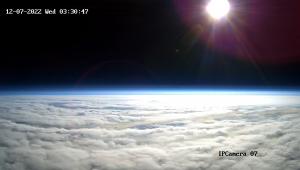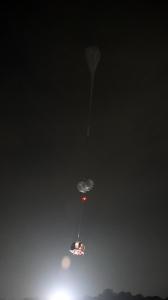HALO Space successfully completes its first test flight
HALO Space flew a balloon carrying a full size prototype of its capsule 37 kilometers into the stratosphere, landing it safely and successfully after 4 hours.
HALO Space’s aerospace balloon, which is made of very thin polycarbonate, weighed 773 kilograms, and reached a maximum diameter between 110 and 130 meters (the length of a soccer field). Powered by hydrogen, the balloon successfully lifted the capsule 37 km into the stratosphere.
According to HALO's CEO Carlos Mira, the inaugural flight went exactly as planned. “Our goal for this first flight was to test real size HALO capsule flight behavior at launch, ascent, cruise, descent and landing, as well as safety systems, ground & onboard equipment, which are the most critical parts of HALO’s flight program. Not only did they perform exactly as expected, we also collected important data from the sensors, instruments, computers and cameras onboard that will be extremely valuable as we continue developing these systems and prepare for the next test flight in a few months.”
HALO Space recorded extensive footage of the flight through nine cameras installed in different points on the capsule and the flight train, and collected critical data from multiple sensors that will be useful for further planning of the second test flight.
Alberto Castrillo, a highly experienced aerospace engineer and CTO of HALO, further explains the role of each of these systems and their performance during the test flight. The mission planning and ground control systems, used to plan the flight route and monitor the real flight, performed optimally and with minimal variation to simulated flight path. “The ability to predict the flight route based on historic and real time data such as winds and other meteorological variables is crucial for our operation”, celebrated Castrillo.
A critical safety system is a parachute that can be deployed at any time and altitude during the flight and land the capsule safely once deployed. Castrillo explained that “In regular flights, a steerable parachute will be deployed at altitudes between 5 and 20 kilometers during the descent. In this first test flight, however, we wanted to demonstrate that, even at the highest altitude of HALO´s flights, we could deploy a parachute and land safely after a stable descent. We are proud to report that we did it at 37 km altitude.”
"We could not be more satisfied," said HALO Space CEO Carlos Mira. "Today, we have demonstrated the viability of the HALO operational concept we’ve been developing. This is a major milestone and another concrete step towards leading the Near Space tourism sector." he added.
The second test flight is scheduled for the first half of 2023 in southern Spain, where HALO Space will test the steerable parachute navigation system as well as advancements to its current systems based on what has been learned from its first flight. HALO Space is aiming for 400 commercial trips, and to carry +3,000 passengers a year by 2029, with a price ranging from $100,000 to $200,000 a ticket.
About HALO Space
HALO Space is a global space tourism company developing a Near Space flight program that will offer zero-emission commercial flights between 25 and 40 kilometers high, allowing passengers to observe the curvature of planet Earth and the vastness of Space in a flight lasting up to 6 hours. This will be possible thanks to its aerospace balloon, equipped with a pressurized capsule with a capacity for eight passengers and a pilot, which will have panel windows offering a 360º view.
Founded in 2021, HALO Space was initially incubated by the prestigious consulting firm Arthur D. Little in its Breakthrough Incubator program. After securing €3 million in seed funding, HALO operates independently and is led by industry veterans Carlos Mira, CEO, and Alberto Castrillo, CTO. HALO Space works closely with top-tier aerospace companies such as CT Engineering Group, Aciturri, GMV and TIFR Balloon Facility in the development of its spaceflight program.
For more information, visit Halo Space (halospaceflight.com).
Tom Huddart
Camarco
+44 2037574980
tom.huddart@camarco.co.uk
Legal Disclaimer:
EIN Presswire provides this news content "as is" without warranty of any kind. We do not accept any responsibility or liability for the accuracy, content, images, videos, licenses, completeness, legality, or reliability of the information contained in this article. If you have any complaints or copyright issues related to this article, kindly contact the author above.


